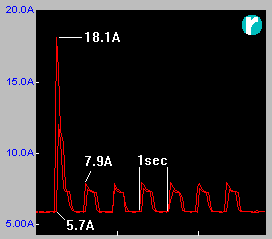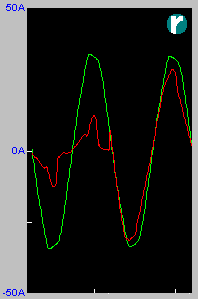|
The complaint was that two out of 6 fluorescent lighting strips flickered periodically during the day. Added to this was the customer would find, approximately once a week, a circuit breaker that had tripped during the night. At first the incoming mains supply was blamed. However, the voltage proved to be exceptionally stable, well below any value that would be noticed. A recording revealed that the load on the customer's site increased dramatically at odd periods. An inexperienced investigator could be led to believe the customer had a piece of equipment or appliance that may be drawing excessive currents e.g. when a fridge starts. A sudden increase in load could be blamed for the caused flicker, and the investigation closed as "internal to customer site".
In this case the flicker was actually caused by a UPS(?) at the customer's site whose input current would increase significantly when the zero crossing was shifted. The device shared the same circuit from the distribution board as the lighting, and being a slightly higher impedance made the lamps extremely susceptible to any load variation on that circuit.
The half cycle immediately after the disturbance shows a distinct lead in the current as a result of the phase locked loop switching the input circuitry at the wrong time. Over the following cycles the current decreases to normal as the PLL returns to lock. Such variations in current can move the voltage on a circuit by many volts, and therefore induce flicker on any lamps connected to such a circuit. The tripping breaker was found to be on a circuit that also fed a fridge and water cooler. When both these items were on at the same time as a disturbance the breaker trip current would be exceeded. Screen shots were of Reliable Power Meters' Power Analysis Software | | Ask a Question | © 07.09.01 |
 Faults:
Faults: Closer investigation proved this load increase to be synchronised to an external event! A test revealed that the flicker coincided with signals being sent on a "Cyclo Mains Signalling System", one that shifts the zero crosscrossing point. But modifying the zero crossing should not affect fluorescent lighting, as is there is a rather large inductor that would easily absorb such variations.
Closer investigation proved this load increase to be synchronised to an external event! A test revealed that the flicker coincided with signals being sent on a "Cyclo Mains Signalling System", one that shifts the zero crosscrossing point. But modifying the zero crossing should not affect fluorescent lighting, as is there is a rather large inductor that would easily absorb such variations. The waveform capture shown alongside indicates a severe current increase at a point short of the zero crossing. What led the investigation towards a hi-tech load was the fact that each and every incident had the same 'signature'. Non hi-tech loads switch on at different points in the cycle.
The waveform capture shown alongside indicates a severe current increase at a point short of the zero crossing. What led the investigation towards a hi-tech load was the fact that each and every incident had the same 'signature'. Non hi-tech loads switch on at different points in the cycle.